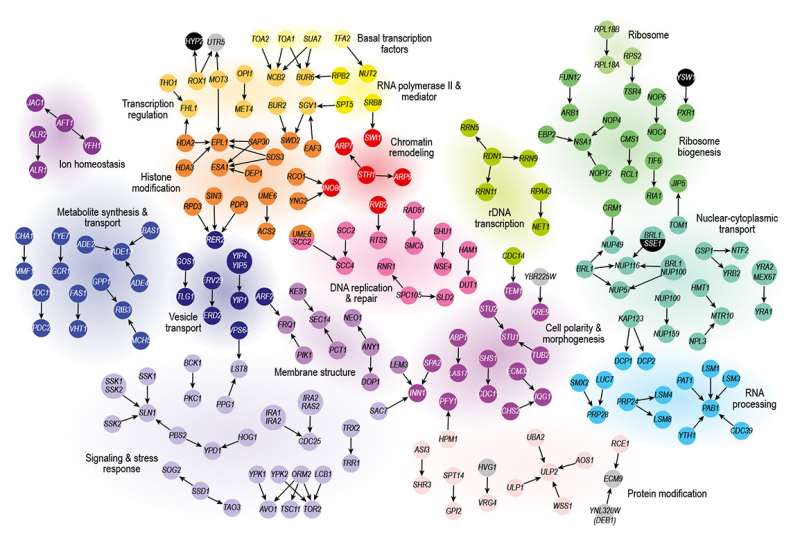The odd special mutation can be very helpful—the trick is knowing how to find them

Geneticist Jolanda van Leeuwen remembers the day she made a striking observation that would take her down a new research path. A strain of yeast cells carrying a complete deletion of an essential gene in their genomes, which should be lethal, somehow thrived in the Petri dish as if perfectly healthy. Van Leeuwen later determined that the cells had developed another mutation that allowed them to bypass the harmful effects associated with the missing gene.
"That was pretty fascinating," says van Leeuwen who was then a postdoctoral fellow in the laboratory of Professors Charles Boone and Brenda Andrews at the Donnelly Center for Cellular and Biomolecular Research and now runs her own group at the University of Lausanne, Switzerland.
"With one single mutation somewhere else in the genome we could erase what was the essential requirement of this gene for cell life, making it completely dispensable," she says.
The phenomenon where a mutation overrides another genetic defect is known as genetic suppression and it is not unique to yeasts. Genome sequencing studies have revealed individuals who remain healthy despite carrying catastrophic inborn errors whose usual harmful effects are somehow masked by other unknown changes in their genomes.
Scientists want to find out which genes are susceptible to genetic suppression as well as identify the suppressor genes, because the knowledge of this genetic rewiring could be harnessed for the development of new therapeutics.
In its simplest form genetic suppression involves an interaction between two genes. But genetic suppression in human cells remains difficult to study on a systematic level owing to a huge number of possible interactions among our 20,000 or so genes. Which is why van Leeuwen and her former mentors Boone and Andrews looked for clues in Baker's yeast cells, which like human cells are eukaryotic, but only have 6,000 genes and are easier to manipulate in the lab. (Eukaryotic cells are larger and more complex than prokaryotic, or bacterial cells).
Their findings, now available online release in the journal Molecular Systems Biology, are the result of the first systematic study of bypass genetic suppression of essential genes in eukaryotic cells, earning them the cover of the journal's September print issue.
Only about 1,000 genes are considered essential for the life of yeast. This study has revealed that at least 17 percent of those can be bypassed through genetic suppression. In other words, the researchers have identified mutations that can compensate for almost a fifth of essential genes when they are deleted from the genome to keep the cells alive. They named the genes that can be bypassed as "dispensable essential" and found that they have common properties.
Dispensable essential genes tend to be functionally related to the genes that override them—their bypass suppressors—and tend to encode supporting rather than core components of cellular machineries.
"These bypass suppressors are special types of genetic interactions because they rewire the cell in such a way that they can live without an important gene," says Andrews, University Professor of molecular genetics and former director of the Donnelly Center. "If that gene causes disease when mutated, it would be useful to know how to rewire a cell to get around that pathogenic defect."
The researchers next wondered if they could identify human essential genes that are in fact dispensable and therefore amenable to suppression. While there's no equivalent human data, some of it can be gleaned from the publicly available Cancer Dependency Map (DepMap) at the Broad Institute in Boston, Massachusetts, which keeps a tally of essential genes across hundreds of cancer cell lines.
Previous work from Professor Jason Moffat's lab at the Donnelly Center, along with two separate groups, established that about 2,000 (or 10 percent) of human genes are essential for cell survival. But, according to DepMap, not all of these genes are required in all the cell lines and can therefore be described as dispensable.
A comparison of human and yeast dispensable essential genes revealed they have similar properties, raising the possibility of computationally predicting clinically relevant bypass suppressors.
One example concerns Shwachman–Diamond syndrome, caused by mutations in a component of the ribosome, the chief cellular machinery for making proteins. A mutation in a separate ribosomal gene TIF6 can override this defect in yeast cells, the study revealed. Remarkably, mutations in the human counterpart of TIF6, called EIF6, have been found in patients with milder symptoms, supporting the rationale for the development of inhibitors of EIF6 to treat the disorder.
The study builds on decades of previous research into how interactions among genes determine trait inheritance at the cellular level. But to find bypass suppressors, the researchers first had to devise a trick that would allow them to grow cells lacking essential genes without which they cannot normally survive.
To get around this, they supplied a backup copy of an essential gene into a strain from which the same gene was deleted from its genome. The gene was introduced on a separate piece of DNA, engineered with a switch so that the gene can be removed from the cell by changing the media on which the cells are growing. Flipping the switch caused the majority of cells to die, allowing occasional survivors that emerged thanks to gaining bypass mutations to be identified.
The genome-wide collection of engineered yeast strains is a unique resource that the researchers are now using to answer other fundamental questions about cellular life.
"It's such a cool and powerful tool that our team invented," says Boone. "We can do all kinds of experiments that previously we would not have been able to do."
More information: Jolanda Leeuwen et al. Systematic analysis of bypass suppression of essential genes, Molecular Systems Biology (2020). DOI: 10.15252/msb.20209828
Journal information: Molecular Systems Biology
Provided by University of Toronto


















